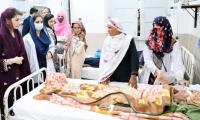On June 16 2015 Donald Trump announced his candidacy to the presidency and set the tone of his priorities. The elimination of illegal immigration to the United States, mainly from refugees fleeing from poverty and violence in Mexico and Central America was one. He didn’t say at the time that his policies included separating children from their parents, some of whom might never meet again.
Immigrants come to the US from Mexico and Central America try to escape abject poverty and food insecurity in their own countries. In Mexico, 2016 data reveal that 52.3 percent of children over 11 years old live under the poverty line, and 9.7 percent live in extreme poverty. Among indigenous children, the figures are more startling. Near 80 percent of them live under the poverty line, and 18.9 percent show symptoms of chronic malnutrition, a reflection of their unhealthy quality of life.
In Guatemala, indigenous populations in rural areas are affected by lack of food and economic burden. Guatemalan children have the third-highest rate of stunting worldwide, an effect of chronic malnutrition. It is estimated that 49.8 percent of Guatemalan children are undernourished, a figure that increases to 69.5 percent in children living in rural, indigenous areas.
As in other Central American countries, stunting and malnutrition in Honduras children are major concerns, particularly for those living in rural areas. It is estimated that 75 percent of the Honduran population live in extreme poverty and 12 percent of households are food-insecure. In rural areas, chronic malnutrition can be as high as 48.5 percent.
In El Salvador, 16.3 percent of rural Salvadoran families cannot cover the costs of basic needs. 18.9 percent of children under age 5 experience chronic malnutrition, a figure that increases to 25.6 percent for those children living in rural areas. In addition, El Salvador is one of the countries with the highest presence of violent juvenile gangs called “maras”.
Nicaragua, which is going presently through a time of considerable social unrest, is considered one of the poorest countries in Latin America. Approximately 29 percent of households live in poverty, and 8.3 percent live in extreme poverty.
The highest rates of child chronic malnutrition occur in what is called the northern Dry Corridor, with rates of almost 30 percent. According to the World Food Programme, 300,000 people are in need of food assistance.
Poverty in Central America is due to factors intrinsic to the countries themselves such as a modern form of feudalism, profound inequality, rampant government corruption, and to foreign interference.
The US has influenced their political and economic situation by helping to overturn democratic governments, as in Guatemala and Honduras, or supporting anti-democratic elements, as in the case of the death squads in El Salvador and the “contras” in Nicaragua.
This dismal picture of poverty and violence explains the desire of those people to seek better conditions for them and their children. “We leave our countries under threat. We leave behind our homes, our relatives, our friends. We are not criminals, we are people living in fear in our countries,” told Maritza Flores, a Salvadoran woman, to the BBC.
This article has been excerpted from: ‘U.S. Policy towards Immigrant Children is not Policy, it is Cruelty’.
Courtesy: Counterpunch.org
After November 30, it will be impossible for ordinary internet users to access all banned websites, including X
Muslims participated alongside their Hindu fellow villagers and other residents of area
For last eight years, HEC's budget has been virtually stagnant in absolute terms
Home to 14 million people, Lahore has always been celebrated as Pakistan’s historical, culinary, and cultural hub
Partnership between Pakistan and China in media and culture reflects shared commitment to strengthening bilateral...
This article focuses on single error committed by our respected judiciary which haunts me more than I would care to...







